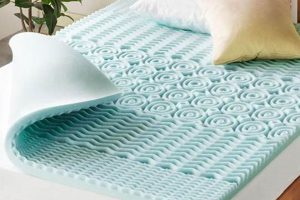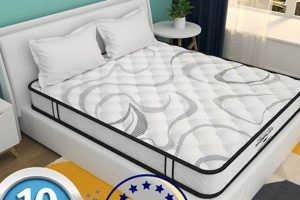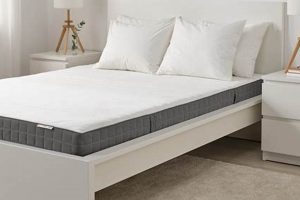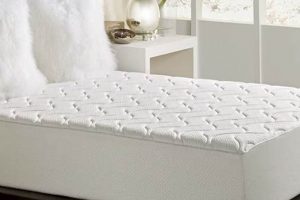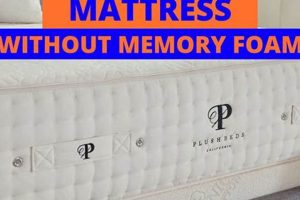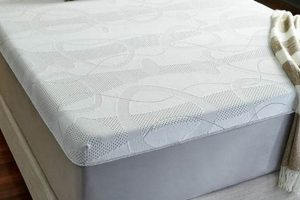These sleeping solutions offer the pressure relief and comfort associated with memory foam, but in a design that prioritizes ease of transport and storage. Typically, these are constructed with layers of memory foam and other materials and often feature a folding or rolling mechanism to minimize their packed size. A practical example would be a tri-fold model designed for camping or guest accommodations.
The convenience of a comfortable sleeping surface that can be readily moved and stored addresses various needs. Their benefits range from providing a familiar sleeping environment while traveling to offering a space-saving bedding option for smaller living spaces. Historically, portable mattresses were rudimentary, prioritizing portability over comfort, but modern materials science has enabled significant improvements in both areas.
The subsequent sections will delve into aspects such as the different types available, the materials used in their construction, their suitability for various uses, and factors to consider when making a purchase decision.
Essential Considerations for Selecting a Compact Memory Foam Bed
This section provides crucial advice for individuals considering the purchase of a sleeping solution that combines the benefits of memory foam with ease of portability.
Tip 1: Assess Intended Use. Determine the primary application. Is it for camping, temporary guest bedding, or regular travel? The frequency and type of use will dictate the necessary durability and comfort level.
Tip 2: Evaluate Foam Density. Higher density foam typically offers greater support and longevity, but also increases weight. Consider the trade-off between support and ease of transport.
Tip 3: Examine Folding Mechanisms. Tri-fold and roll-up designs are common. Ensure the chosen mechanism is robust and easy to operate, with secure closures to maintain a compact form during transport.
Tip 4: Prioritize Breathability. Memory foam can retain heat. Look for models with breathable covers or integrated ventilation to mitigate overheating during sleep.
Tip 5: Verify Dimensions. Confirm that the unfolded dimensions meet the user’s size requirements and that the folded dimensions are compatible with storage or transport constraints.
Tip 6: Review Cover Material. The cover should be durable, washable, and resistant to wear and tear. Consider waterproof options for outdoor applications.
Tip 7: Check for Certifications. Look for certifications such as CertiPUR-US, which indicate that the foam has been tested for harmful chemicals and emissions.
Careful consideration of these factors will ensure the selection of a comfortable, durable, and appropriately sized sleeping surface that meets specific needs and maximizes the benefits of both memory foam and portability.
The subsequent sections will explore specific product recommendations and delve deeper into the maintenance and care of this type of bedding.
1. Portability
Portability is the defining characteristic of this product category. It directly addresses the need for a comfortable sleeping surface that can be readily transported and stored, differentiating it from traditional, stationary mattresses.
- Weight and Size
Weight and packed dimensions are paramount. A lighter and more compact folded or rolled configuration allows for easier handling and storage in vehicles, closets, or luggage compartments. Exceedingly heavy or bulky models negate the benefits of the design, making transport challenging for a single individual.
- Folding/Rolling Mechanism
The efficiency and robustness of the folding or rolling mechanism are critical. A well-designed mechanism allows for quick and easy packing and unpacking, while a durable construction ensures the product withstands repeated use and transport without damage. Examples include tri-fold designs with secure straps or roll-up models with durable carrying bags.
- Carrying and Storage Features
Integrated carrying handles, straps, or included storage bags significantly enhance convenience. These features facilitate easier lifting, carrying, and protection of the product during transport and storage. The absence of such features can make handling cumbersome and increase the risk of damage.
- Durability During Transport
The ability to withstand the rigors of transport is essential. Durable outer materials, reinforced seams, and protective coatings contribute to the product’s resilience against tearing, abrasion, and moisture damage during handling and transit. This ensures the longevity of the sleeping surface, even with frequent use.
These interwoven aspects of portability are fundamental to the utility of a portable memory foam mattress. Their interplay directly impacts the user’s ability to comfortably and conveniently utilize the product in various settings, ranging from camping expeditions to temporary guest accommodations.
2. Foam Density
Foam density, measured in pounds per cubic foot (lbs/ft), is a critical attribute affecting the performance and suitability of a memory foam mattress, particularly within the context of portable models. A direct correlation exists between foam density and factors such as support, durability, and overall comfort. Higher density foam generally provides increased support by distributing weight more effectively, leading to reduced pressure points and improved spinal alignment. This is especially pertinent for individuals seeking relief from back pain or those who require a firmer sleeping surface. Lower density foam, while potentially more pliable, tends to compress more readily under pressure, resulting in diminished support and a shorter lifespan.
The choice of foam density in a portable design represents a compromise between comfort and portability. High-density foam, while offering superior support and longevity, adds weight to the final product, potentially hindering its intended ease of transport. Conversely, lower density foam reduces weight but compromises the benefits of memory foam, such as pressure relief and conforming support. Consider a tri-fold mattress marketed for camping: If its foam density is too low (e.g., less than 3 lbs/ft), it may lack adequate support for extended use on uneven surfaces. A density of 4-5 lbs/ft might strike a better balance, providing sufficient support without excessive weight. A too-high density (e.g., above 5 lbs/ft), while durable, may be impractical for carrying on hiking trips.
In summary, the optimal foam density for these models hinges on the intended use case. Prioritizing portability might necessitate a slightly lower density, while emphasizing long-term support and durability demands a higher density foam. Understanding this trade-off en
ables informed decision-making, ensuring that the selected product aligns with specific needs and expectations regarding both comfort and ease of transport. The selection should be based on striking the most sensible balance between ease of transport and support for proper use.
3. Foldability
Foldability is an inherent and crucial characteristic of a portable memory foam mattress, directly dictating its ease of transport and storage. The effectiveness of this product type is predicated on its ability to be compacted into a manageable size for convenient handling. A mattress, regardless of its comfort properties, ceases to be “portable” if its dimensions or construction preclude straightforward folding or rolling.
The relationship between foldability and a memory foam mattress is a cause-and-effect dynamic. The design and materials used directly influence the manner and extent to which it can be folded or rolled. For instance, a tri-fold design, common in this product category, allows the mattress to be collapsed into thirds, secured by straps or fasteners. Conversely, a single-piece memory foam mattress without specific folding provisions would be significantly more challenging to transport. The absence of effective foldability severely limits the practical application of a memory foam mattress in scenarios where space constraints are a concern, such as camping, travel, or temporary guest accommodations.
The practical significance of foldability is evident in scenarios where storage space is limited. Consider individuals residing in apartments or smaller homes: A foldable memory foam mattress provides a comfortable sleep solution that can be easily stowed away when not in use, maximizing available living space. Similarly, campers benefit from the reduced volume and weight offered by a foldable design, enabling them to transport a more comfortable sleeping surface without sacrificing valuable cargo space. A failure to prioritize foldability in the design process undermines the core value proposition of a portable memory foam mattress: the combination of comfort and convenient transportability.
4. Support
Support is an essential consideration for portable memory foam mattresses, directly influencing user comfort, spinal alignment, and overall sleep quality. The degree of support provided determines how well the mattress distributes body weight, alleviates pressure points, and maintains proper spinal posture. Inadequate support can lead to discomfort, pain, and disrupted sleep, negating the benefits of memory foam. The cause of poor support is often related to low foam density, insufficient thickness, or a lack of a supportive base layer. For instance, a thin memory foam topper placed directly on the floor will offer minimal support compared to the same topper placed on a firm base or platform.
The importance of support is amplified in portable applications, where users may be sleeping on uneven surfaces or in less-than-ideal conditions. Camping scenarios, for example, often involve placing the mattress on the ground, which may be rocky or uneven. A portable mattress with sufficient support can mitigate these challenges, providing a more comfortable and restful sleep experience. Similarly, when used as a temporary guest bed, a supportive portable mattress can enhance guest satisfaction and minimize complaints of discomfort. The practical application lies in selecting a mattress with adequate foam density, thickness, and potentially a supportive base layer to ensure consistent support regardless of the underlying surface. Consider a tri-fold mattress with a high-density foam core and a firm base layer designed for camping. This configuration maximizes support and helps to compensate for uneven terrain.
In conclusion, the level of support offered by a portable memory foam mattress is a crucial determinant of its effectiveness and user satisfaction. Achieving an optimal balance between portability and support requires careful consideration of foam density, mattress thickness, and the presence of a supportive base layer. This understanding is particularly relevant for individuals who rely on these mattresses for consistent comfort in diverse settings, where surface conditions may vary. Ignoring the support aspect can lead to compromised sleep quality and reduced usability, thereby undermining the intended benefits of the product.
5. Breathability
Breathability, in the context of a portable memory foam mattress, refers to the material’s capacity to allow air circulation and moisture wicking. Memory foam, by its nature, tends to retain heat due to its dense cellular structure, which can impede airflow. This inherent characteristic poses a challenge for users, potentially leading to discomfort caused by overheating, especially during warmer seasons or in poorly ventilated environments. The cause is a closed-cell foam structure that limits airflow. Its effect is a warmer sleep, which can be undesirable. The importance of breathability arises from the need to mitigate this heat retention and maintain a comfortable sleep temperature. A direct example is a portable mattress used for camping in humid conditions. If the mattress lacks breathability, the user may experience excessive sweating and a restless night.
Manufacturers address the breathability issue through various design and material innovations. Open-cell memory foam, gel-infused foam, and ventilated designs are common approaches. Open-cell structures create pathways for air to circulate through the foam, while gel infusions can absorb and dissipate heat. Ventilated designs incorporate perforations or channels to enhance airflow. Cover materials also play a significant role, with breathable fabrics like cotton, bamboo, or specialized performance fabrics promoting moisture wicking and air exchange. Practical applications can be seen in the product descriptions of portable mattresses that highlight these features. Terms like “cooling gel,” “open-cell technology,” or “moisture-wicking cover” directly indicate efforts to improve breathability and enhance user comfort.
In summary, breathability is a crucial performance factor for portable memory foam mattresses. The material’s inherent heat retention necessitates design and material modifications to promote airflow and moisture wicking. Without adequate breathability, users may experience discomfort due to overheating, particularly in warmer environments. An understanding of the relationship between material properties, design features, and breathability enables informed decision-making when selecting a portable memory foam mattress, ensuring a more comfortable and restful sleep experience. A future trend is likely the increased use of plant-based foams that are more naturally breathable than petroleum-based options.
6. Dimensions
The dimensions of a portable memory foam mattress are a critical determinant of its practicality and suitability for intended applications. Dimensions encompass both the unfolded size, influencing sleeping comfort, and the folded or rolled size, directly impacting portability and stora
ge convenience. An inadequate unfolded size restricts sleeping space, leading to discomfort, while excessive folded dimensions negate the advantage of easy transport. The interplay between these two sets of dimensions is fundamental to the product’s functionality. The cause of an ill-fitting mattress might be insufficient length to accommodate the user’s height, resulting in dangling feet and disrupted sleep, or excessive width for a tent, creating a cramped camping environment.
The significance of dimensions is evident in various real-world scenarios. For instance, when selecting a portable mattress for a child’s sleepover, compact folded dimensions for easy carrying are paramount, while the unfolded size must be adequate for a child’s body. Conversely, an adult using a portable mattress for extended camping trips requires a larger unfolded size for comfortable sleep, balanced against the ability to fit the packed mattress into a vehicle’s cargo space. A practical application involves carefully measuring available storage space (e.g., a car trunk, a closet shelf) and comparing these measurements to the folded dimensions of prospective mattresses. This ensures that the chosen product can be conveniently stored when not in use. Another example is when used as a guest bed for an adult. If you bought the twin size, there is not enough space for an adult.
In summary, the dimensions of a portable memory foam mattress are not merely arbitrary measurements but are integral to its usability and effectiveness. Understanding the relationship between unfolded and folded dimensions, and considering the specific needs of the user and the intended application, is crucial for making an informed purchase. Challenges arise when manufacturers prioritize either comfort or portability to the detriment of the other, requiring consumers to carefully weigh trade-offs based on their individual requirements. A properly dimensioned product enhances both the sleeping experience and the ease of handling, aligning with the core value proposition of portable bedding solutions.
7. Durability
Durability, in the context of portable memory foam mattresses, refers to the product’s capacity to withstand repeated use, handling, and environmental exposure without significant degradation in performance or structural integrity. It is a critical factor influencing the lifespan, value, and overall user satisfaction with these sleeping solutions.
- Foam Resilience and Density
The inherent resilience and density of the memory foam core directly impact the mattress’s long-term durability. Higher density foams tend to exhibit greater resistance to compression and deformation over time, maintaining their supportive properties and preventing sagging. Conversely, lower density foams are more susceptible to breakdown with repeated use, leading to a reduction in comfort and support. For example, a portable mattress used frequently for camping on uneven terrain requires a high-density foam to withstand the constant pressure and maintain its shape.
- Cover Fabric and Stitching Strength
The quality and construction of the cover fabric are crucial for protecting the foam core from abrasion, tears, and moisture damage. Durable, tightly woven fabrics with reinforced seams and robust stitching enhance the mattress’s ability to withstand handling during transport and storage. Weak or poorly stitched covers are prone to ripping, exposing the foam to potential damage and reducing the mattress’s lifespan. An instance of this is a mattress cover exposed to sunlight for prolonged periods; UV-resistant fabrics are necessary to prevent degradation.
- Folding Mechanism Integrity
For foldable models, the durability of the folding mechanismhinges, straps, and fastenersis paramount. These components must withstand repeated folding and unfolding without weakening or breaking. Inferior folding mechanisms can compromise the mattress’s portability and structural integrity, rendering it unusable. A durable hinge ensures that the folding process does not stress the foam, prolonging the lifespan of the overall product.
- Resistance to Environmental Factors
Portable mattresses are often subjected to diverse environmental conditions, including humidity, temperature fluctuations, and exposure to dirt or moisture. Materials with inherent resistance to these factors, or those treated with protective coatings, contribute to the mattress’s durability. For example, water-resistant covers prevent moisture from seeping into the foam, inhibiting mold growth and preserving its integrity. A mattress used in varying climates will require specific material adaptations to maintain its structural integrity. For example, a mattress used at high altitudes will need breathable material to minimize the effect of altitude on the mattresses condition.
These interconnected facets highlight the importance of durability as a holistic attribute of portable memory foam mattresses. Selecting a product constructed with resilient materials, robust components, and thoughtful design considerations ensures a longer lifespan, sustained comfort, and enhanced value, particularly in demanding usage scenarios. An appropriate product with high level of durability can withstand the elements of varied conditions and long periods of uses.
Frequently Asked Questions
This section addresses common inquiries regarding portable memory foam mattresses, providing clear and concise answers to aid in informed decision-making.
Question 1: What is the typical lifespan of a portable memory foam mattress?
The lifespan varies significantly based on factors such as foam density, usage frequency, and care. Higher density foams and proper maintenance contribute to increased longevity. Generally, a lifespan of 3 to 7 years can be expected with regular use.
Question 2: Are these mattresses suitable for individuals with back pain?
These mattresses can provide relief for some individuals with back pain due to their pressure-relieving properties. However, the level of support is crucial. A mattress with insufficient support may exacerbate back pain. It is advisable to consult a healthcare professional for personalized recommendations.
Question 3: How should a portable memory foam mattress be cleaned and maintained?
Spot cleaning with a mild detergent and water is recommended for most stains. The cover, if removable, should be washed according to the manufacturer’s instructions. Avoid harsh chemicals and excessive moisture. Regular airing out can help prevent the buildup of odors.
Question 4: Can these mattresses be used on a box spring or platform bed?
While primarily designed for portable use, these mattresses can be placed on a box spring or platform bed to provide a memory foam layer. However, ensure that the existing support structure is adequate to prevent sagging or uneven weight distribution.
Question 5: What is the difference between open-cell and closed-cell memory foam in these mattresses?
Open-cell memory foam has a more porous structure, allowing for increased airflow and breathability, which helps to regulate temperature. Closed-cell foam is denser and retains more heat but typically offers greater support. The choice depends on individual preferences regarding temperature sensitivity.
Question 6: How do the fire safety regulations apply to portable memory foam mattresses?
Portable memory foam mattresses are subject to the same fire safety regulations as stan
dard mattresses. Manufacturers must comply with flammability standards, often incorporating fire-resistant barriers or treated materials. Verify that the product meets relevant safety certifications before purchase.
This FAQ section provides essential information regarding the characteristics, maintenance, and suitability of portable memory foam mattresses. Careful consideration of these factors will contribute to a more informed purchasing decision.
The following section will explore specific product recommendations, focusing on various price points and use cases.
Conclusion
This exploration has illuminated the multifaceted aspects of the portable memory foam mattress, ranging from fundamental characteristics like foam density and foldability to critical performance considerations such as support, breathability, and durability. The analysis emphasized the inherent trade-offs involved in balancing portability with the comfort and longevity typically associated with memory foam technology. Successfully navigating these trade-offs hinges on a clear understanding of intended use cases and individual requirements.
The portable memory foam mattress represents a convergence of convenience and comfort, offering a viable sleeping solution across diverse scenarios. Its continued relevance depends on ongoing material science advancements and design innovations that further optimize both portability and performance. Consumers are encouraged to carefully evaluate their specific needs and prioritize features that align with their intended applications to make informed purchasing decisions.


